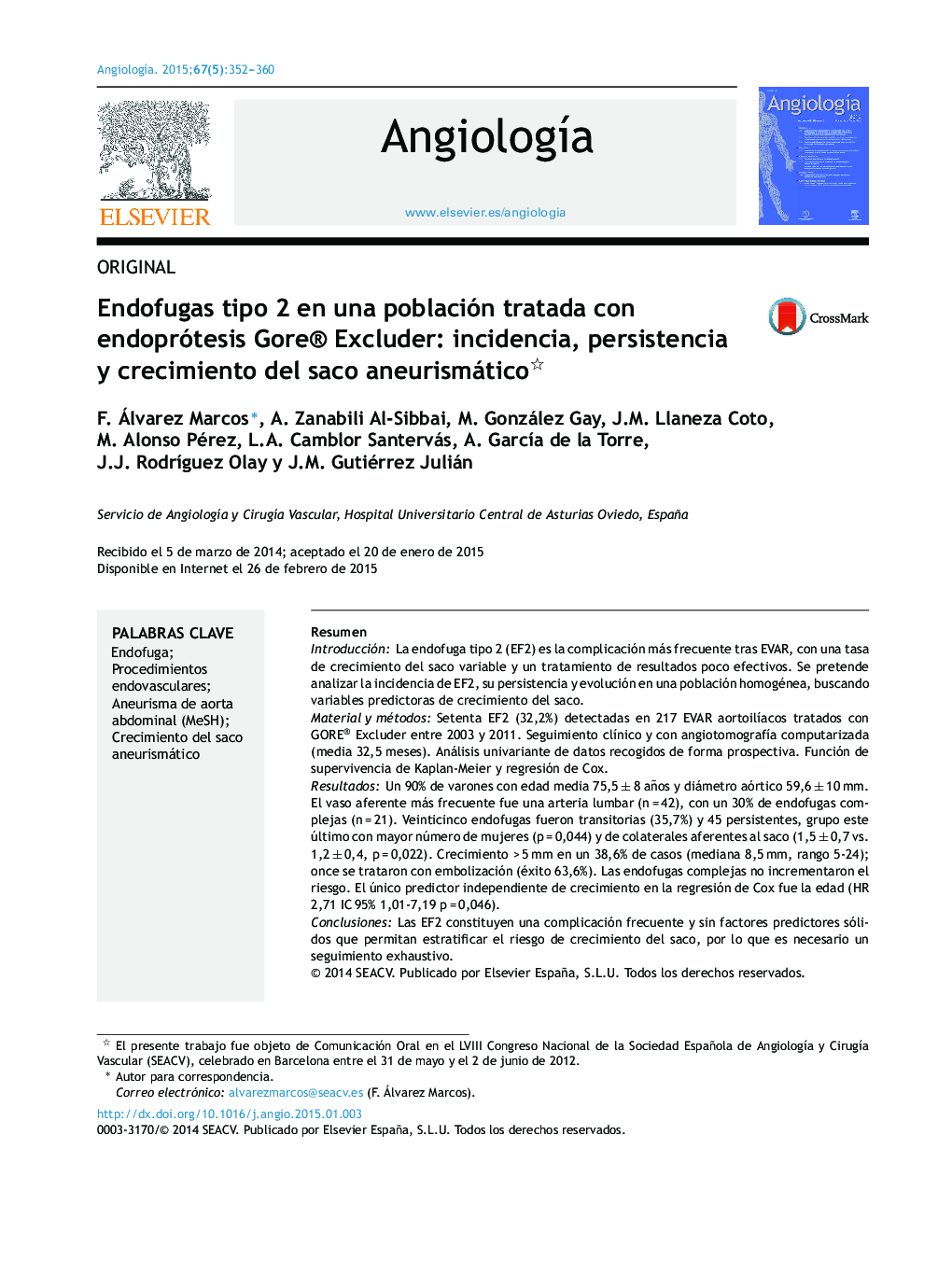| کد مقاله | کد نشریه | سال انتشار | مقاله انگلیسی | نسخه تمام متن |
|---|---|---|---|---|
| 2867559 | 1171094 | 2015 | 9 صفحه PDF | دانلود رایگان |

ResumenIntroducciónLa endofuga tipo 2 (EF2) es la complicación más frecuente tras EVAR, con una tasa de crecimiento del saco variable y un tratamiento de resultados poco efectivos. Se pretende analizar la incidencia de EF2, su persistencia y evolución en una población homogénea, buscando variables predictoras de crecimiento del saco.Material y métodosSetenta EF2 (32,2%) detectadas en 217 EVAR aortoilíacos tratados con GORE® Excluder entre 2003 y 2011. Seguimiento clínico y con angiotomografía computarizada (media 32,5 meses). Análisis univariante de datos recogidos de forma prospectiva. Función de supervivencia de Kaplan-Meier y regresión de Cox.ResultadosUn 90% de varones con edad media 75,5 ± 8 años y diámetro aórtico 59,6 ± 10 mm. El vaso aferente más frecuente fue una arteria lumbar (n = 42), con un 30% de endofugas complejas (n = 21). Veinticinco endofugas fueron transitorias (35,7%) y 45 persistentes, grupo este último con mayor número de mujeres (p = 0,044) y de colaterales aferentes al saco (1,5 ± 0,7 vs. 1,2 ± 0,4, p = 0,022). Crecimiento > 5 mm en un 38,6% de casos (mediana 8,5 mm, rango 5-24); once se trataron con embolización (éxito 63,6%). Las endofugas complejas no incrementaron el riesgo. El único predictor independiente de crecimiento en la regresión de Cox fue la edad (HR 2,71 IC 95% 1,01-7,19 p = 0,046).ConclusionesLas EF2 constituyen una complicación frecuente y sin factores predictores sólidos que permitan estratificar el riesgo de crecimiento del saco, por lo que es necesario un seguimiento exhaustivo.
IntroductionType 2 endoleaks (T2E) are the most common finding after endovascular aortic repair (EVAR), with a variable sac growth rate and a treatment with unpromising results. The aim of this study is to analyze the incidence of T2E and their evolution in a homogeneous population, seeking predictors for sac growth.Material and methodsA total of 70 T2E (32.2%) were detected in 217 aorto-iliac EVAR treated with a GORE® Excluder endograft from 2003 to 2011. They were systematically followed-up with contrast enhanced tomography (mean 32.5 months). Univariate analysis of prospectively collected data; Kaplan-Meier survival functions and multivariate Cox regression.Results90% of patients with T2E were males, with a mean age 75.8 ± 8 years, and mean aortic diameter 59.5 ± 10 mm. The most common persistent collateral vessel was a lumbar artery (n = 42), with 30% of complex T2E (n = 21). The endoleaks were transient in 25 cases (35.7%), and 45 persisted for more than 6 months, the latter with a higher percentage of women (p = 0.044), and total number of afferent vessels (1.5 ± 0.7 vs. 1.2 ± 0.4, p = 0.022). Sac growth over 5 mm was observed in 38.6% of cases (median 8.5 mm, rank 5-24), with eleven of those treated with trans-arterial or trans-lumbar embolization (63.6% success). Complex endoleaks did not show a higher risk profile. Age was the only independent risk factor in the Cox regression analysis (HR 2.71, 95% CI; 1.01-7.19 p = 0.046).ConclusionsT2E are a frequent complication, with no solid predictive factors for stratifying sac growth risk, thus needing close surveillance.
Journal: Angiología - Volume 67, Issue 5, September–October 2015, Pages 352–360